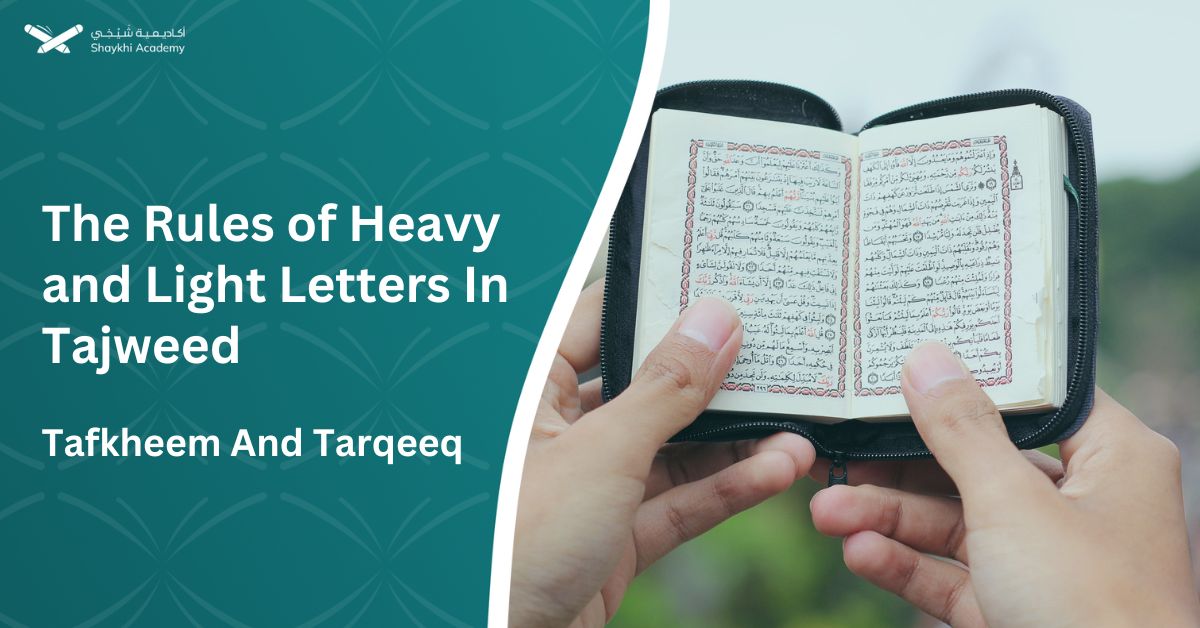letters are classified based on their phonetic characteristics into two main types: heavy (Tafkheem) and light (Tarqeeq). Tafkheem letters are pronounced with a fuller, stronger sound, while Tarqeeq letters are articulated with a thinner, softer tone. Most Arabic letters are naturally light, but seven specific letters always carry a heavy quality. Some letters, like the “Lam” in “Allah” and “Ra,” can shift between heavy and light, depending on the context. This balance of emphasis and attenuation enriches the recitation, adding depth and clarity to the Quran’s melodious flow.
The Arabic letters have many attributes, some of which are inherent and some are incidental. Among the incidental attributes are the qualities of Tafkheem (emphasis) and Tarqeeq (attenuation), which are characteristics of letters in the science of Tajweed (the art of reciting the Quran). These are phonetic attributes produced from the pharynx, and the two cannot coexist in a single letter because they are opposites.
Introduction To Understand The Arabic Letters Nature:
Arabic letters in Tajweed are classified into emphatic letters, attenuated letters, and letters that can be either emphatic or attenuated depending on the context. All Arabic letters are inherently attenuated except for seven letters, known as Musta’liyah (elevated), which are pronounced with the tongue raised towards the roof of the mouth.
The rest of the letters are attenuated except for Lam and Ra, which can be either emphatic or attenuated. Additionally, there is one letter that follows the previous letter in terms of emphasis or attenuation, which is the long vowel Alif (ا).
Definition of Tafkheem (التفخيم)
In Arabic, Tafkheem means magnification and intensification, and in Tajweed, it refers to making the letter sound fuller and stronger. This attribute is specific to seven Arabic letters, which are collected in the mnemonic “خص ضغط قظ” (khuṣ Ḍaġṭin Qiẓ). These letters are emphatic in Tajweed and are pronounced with a heavier, stronger quality.
Levels of Tafkheem (مراتب التفخيم)
Emphasis (Tafkheem) is not uniform; it varies in intensity and is divided into five different levels, ranked from strongest to weakest as follows:
1. An emphatic letter with a fatḥa (a vowel mark indicating a short “a” sound) followed by an Alif: {طَاغِينَ} (Tāghīn).
2. An emphatic letter with a fatḥa but not followed by an Alif: {صَبَرَ} (Ṣabara).
3. An emphatic letter with a ḍamma (a vowel mark indicating a short “u” sound): {فَضُرِبَ} (Faḍuriba).
4. An emphatic letter that is sukun (silent): {فَاقْضِ} (Faqḍi).
5. An emphatic letter with a kasra (a vowel mark indicating a short “i” sound), which is the weakest level of emphasis: {خِيَانَةً} (Ḫiyānah)
The Letters of Tafkheem With Examples
The Holy Quran is filled with examples of letters with different levels of Tafkheem (emphasis). Some of them include:
1. The letter Ḍād (ض) in the verse:
“وَلاَ الضَّالِّينَ” (Al-Fatiha 7) (“Wa lā ḍ-ḍāllīn”).
2. The letter Qāf (ق) in the verse:
“حَتَّى زُرْتُمُ الْمَقَابِرَ” (At-Takathur 2) (“Ḥattā zurtum al-maqābir”).
This is an example of the highest level of Tafkheem because both letters have a fatḥa and are followed by an Alif.
3. The letter Ṣād (ص) in the verse:
“اللَّهُ الصَّمَدُ” (Al-Ikhlas 2) (“Allāhu ṣ-ṣamad”).
4. The letter Ghayn (غ) in the verse:
“غُلِبَتِ الرُّومُ” (Ar-Rum 2) (“Ghulibat ir-rūm”).
5. The letter Ṭāʾ (ط) in the verse:
“يَا أَيَّتُهَا النَّفْسُ الْمُطْمَئِنَّةُ” (Al-Fajr 27) (“Yā ayyatuhā n-nafsul muṭmaʾinnah”).
6. The letter Khāʾ in the verse:
“وَيُخْرِجُكُمْ إِخْرَاجًا” (Nuh 18) (“Wa yukhrijukum ikhrājā”).
7. The letter Ẓāʾ (ظ) in the verse:
“ظَهَرَ الْفَسَادُ فِي الْبَرِّ وَالْبَحْرِ بِمَا كَسَبَتْ أَيْدِي النَّاسِ” (Ar-Rum 41) (“Ẓahara l-fasādu fi l-barri wal-baḥri bimā kasabat aydī n-nās”).
Definition of Tarqeeq (الترقيق)
In Arabic, the term “tarqiq” (softening) comes from “riqqa,” meaning thinness, as opposed to “samn,” meaning fatness. In the science of Tajweed, it refers to making a letter sound thin by producing it from a slender, weak articulation point.
This characteristic is found in all the Arabic alphabet letters except for the seven letters associated with “tafkhim” (thickening). Softening can also be described as a thinning that affects the letter, preventing the mouth from being filled with its echo.
The Letters of Tarqeeq With Examples
Examples of Ayahs with Fully Softened Letters:
يَحْسَبُونَ الْأَحْزَابَ لَمْ يَذْهَبُوا
Yahsaboon al-ahzaaba lam yathhaboo (Al-Ahzab 20)
وَمَا زَادَهُمْ إِلَّا إِيمَانًا وَتَسْلِيمًا
Wama zaadahum illa eemanan wa tasleema (Al-Ahzab 22)
وَمَا بَدَّلُوا تَبْدِيلًا
Wama baddaloo tabdeela (Al-Ahzab 23
Tafkheem and Tarqeeq Examples
Many verses of the Qur’an contain both softened and thickened letters within the same word. Here are some examples with an explanation of the softened and thickened letters:
1. Word خالدين (Khalideena):
The letter “خ” (khaa) is thickened because it has a fatha (a).
The “ألف” (alif) is also thickened because it follows a thickened letter with a fatha.
The letters “ل” (laam), “د” (daal), “ي” (yaa), and “ن” (noon) are softened letters.
2. Word الصَّلَاةَ (As-Salaata):
The letter “ص” (saad) is thickened because it is one of the thickened letters and it has a fatha.
The “ل” (laam) is a softened letter.
The “ألف” (alif) after it is softened.
The “ت” (taa) at the end of the word is softened.
3. Word يَضْرِبُونَ (Yadriboona):
The letter “ي” (yaa) is softened.
The “ض” (daad) is thickened as it is one of the thickened letters and is in a sukoon state.
The “ر” (raa) is softened here because it has a kasra (i).
The letters “ب” (baa), “و” (waw), and “ن” (noon) are softened.
4. Word الْمَغْضُوبِ (Al-Maghdoobi):
The “م” (meem) is a softened letter.
The “غ” (ghayn) and “ض” (daad) are thickened letters and pronounced with thickening.
The “و” (waw) and “ب” (baa) are softened letters.
5. Word: العَرْشِ (Al-Arshi):
The letter “ع” (ayn) is pronounced softened.
The “ر” (raa) in this case is thickened because it is preceded by a letter with a fatha.
The “ش” (sheen) is a softened letter.
Letters That Could be With Tafkheem and With Tarqeeq
In Arabic letters, there are three letters that can be thickened in certain cases and softened in others. These letters are the “lam” in the word “Allah,” the “alif,” and the “ra.” They are explained as follows:
1. Alif (ا):
The “alif” itself does not have a specific articulation point to be described as thick or thin. Its softening or thickening depends on the preceding letter:
If it follows a thickened letter, it becomes thickened, such as in: (طَالَ) (الضَّالَّينَ) (الصَّابِرِينَ) (الظَّالِمِينَ) (الْغَالِبِينَ) (الْخالِدِينَ) (وَرَاءِكُمْ) (الأرائِكِ).
If it follows a softened letter, it becomes softened, such as in: (جاءَ) (أَفاءَ) (ساءَ) (التَّائِبُونَ).
2. The “Lam” in the Word “Allah” (اللام في كلمة الله):
The “lam” in “Allah” must be thickened if it follows a fatha (e.g., قَالَ اللَّهُ “qala Allahu”) or a dhamma (e.g., رُسُلُ اللَّهِ “rusulu Allahi”). This applies whether the word “Allah” is in isolation or joined with “humma” (e.g., اللَّهُمَّ “Allahumma”). It must be softened if it follows a kasra, whether the kasra is directly connected to “Allah” (e.g., بِاللَّهِ “biAllahi”) or separate (e.g., أَفِي اللَّهِ شَكٌّ “afi Allahi shakkun”), or if the kasra is incidental (e.g., مَّا يَفْتَحِ اللَّهُ “ma yaftahi Allahu”).
The default state of the “lam” is to be softened unless it meets one of the conditions for thickening mentioned above.
3. The Letter “Ra” (ر):
The “ra” typically should be softened because it is a letter of “istifal” (lowering), but due to its unique articulation point and qualities, it has adopted a thickening characteristic. This has made thickening its default, with softening being secondary. Thus, scholars generally say the default for “ra” is thickening, and it is softened only if certain conditions are met. The reasons for its softening include the presence of a kasra, a following ya, or an inclination. If the “ra” is fatha or dhamma, it must be thickened (e.g., رَبَّنَا “rabbana”, رَءُوفٌ رَّحِيمٌ “ra’oofun raheem”, رُعْبًا “ru’ban”, رُّبَمَا “rubama”). If the “ra” is kasra, it must be softened (e.g., رِزْقًا “rizqan”, رِجَالٌ “rijalun”, رِحْلَةٌ “rihlatun”) or in the middle of a word (e.g., قَرِيبٌ “qareebun”, فَرِيًّا “fareeyan”).
Learn Tajweed with Shaykhi Academy
Shaykhi Academy is a scholarly academy that offers professional online lessons in Arabic language, Quranic sciences, and Tajweed with specialized teachers in their fields, boasting significant teaching experience and high proficiency.
The lessons are available for both beginners and advanced learners, with the opportunity to obtain accredited certifications. Additionally,Shaykhi Academy offers lessons exclusively for women in all fields, establishing itself as a scientific edifice for anyone wishing to master the recitation of the Holy Qur’an.
We ask Allah to reward our efforts and yours and to make us among those who learn the Qur’an and recite it as it should be recited.
Why Choose Shaykhi Academy?
- Connect with highly qualified native tutors.
- Flexible scheduling to suit your busy lifestyle.
- Affordable classes tailored for all levels.
- Accessible from anywhere around the globe.
Discover Our Range of Courses:
- Arabic Noorani Qaida: Lay a solid foundation for Quranic studies.
- Online Quran Classes for Kids: Engaging lessons for lifelong learning.
- Tajweed Rules for Kids: Learn to recite with confidence.
- Quran Hifz for Kids: Step-by-step guidance to memorize the Quran.
- Quran for Adults: Introduce yourself to Quran reading and Tajweed rules.
- Online Arabic Courses: Master the language of the Quran.
- Islamic Studies: A wide range of topics related to Islam, including theology, law, Quranic studies, and Hadith.
Don’t Miss Out on Your Chance to Excel! Whether you’re a beginner or seeking advanced knowledge, Shaykhi Academy can guide you! Book your free trial now

Conclusion
The attributes of the letters give them distinctive pronunciations and unique sounds. The thickening (tafkhim) and softening (tarqiq) specifically refer to the nature of this sound, making it either thick and heavy or thin and light during pronunciation.
These are incidental characteristics. We have defined each separately and mentioned the seven letters of thickening (خص ضغط قظ – Kha, Saad, Dha, Gha, T, Qaf, Dhaad) and explained the rest of the softened letters.
We also explained the letters that can be thickened at times and softened at other times, such as the “lam” in the word “Allah,” the “alif” that follows the preceding letter, and the “ra.”
We hope that by reading this article, you have gained a better understanding of thickening and softening. We ask Allah Almighty to teach us what benefits us, to benefit us from what He has taught us, and to make the Holy Qur’an a path for us to Paradise.

















































